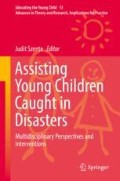Abstract
Schools, including teachers, are an integral part of the community and are patently linked to children and families. A community must consider the physical and mental health of is youngest members. This includes providing access to safe drinking water, nutritious food, medical care, crisis mental health counseling, as well as ongoing mental health services and supports. The focus of this chapter is twofold: (1) identifying the impact of hurricanes on teachers, schools, and school districts and (2) identifying the impact of hurricanes on children, families, and the community at large. The chapter also provides strategies for early childhood educators and school administrators to proactively plan for various natural disasters and provides recommendations for addressing the physical, mental, and social-emotional needs of children and their families after a hurricane or other natural disasters.
Access this chapter
Tax calculation will be finalised at checkout
Purchases are for personal use only
References
Barkemeyer, B. M. (2006). Practicing neonatology in a blackout: The University Hospital NICU in the midst of Hurricane Katrina: Caring for children without power or water. Pediatrics, 117, 369–374.
Biggar, R. W. (2015). The aftermath of a natural disaster: A phenomenological study of permanent displacement among adult survivors of Hurricane Katrina. Doctoral dissertation. Retrieved from http://gradworks.umi.com/37/00/3700471.html
CNN. (2013). Hurricane Katrina statistics fast facts. Retrieved from http://www.cnn.com/2013/08/23/us/hurricane-katrina-statistics-fast-facts/
Gouwens, J., & Lander, D. (2008). School leadership in changing cultural contexts: How Mississippi superintendents are responding to Hurricane Katrina. Journal of Education for Students Placed at Risk, 13, 273–296.
Guha-Sapir, D., Van Panhuis, W. G., & Lagoutte, J. (2007). Short communication: patterns of chronic and acute diseases after natural disasters – A study from the International Committee of the Red Cross field hospital in Banda Aceh after the 2004 Indian Ocean tsunami. Tropical Medicine & International Health, 12(11), 1338–1341.
Hernandez, P., Gangsei, D., & Engstrom, D. (2007). Vicarious resilience: A new concept in work those who survive trauma. Family Process, 46(2), 229–241.
Howat, H., Curtis, N., Landry, S., Farmer, K., Kroll, T., & Douglass, J. (2012). Lessons from crisis recovery: How hurricanes impacted, schools, families and the community. School Leadership & Management, 32(5), 487–501.
Kline, M., Schonfield, D. J., & Lichtenstein, R. (1995). Benefits and challenges of school-based crisis response teams. Journal of School Health, 65(7), 245–249.
Kousky, C. (2016). Impacts of natural disasters on children. Future of Children, 26(1), 73–92.
Osofsky, H. J., Osofsky, J. D., Kronenberg, M., Brennan, A., & Hansel, T. C. (2009). Post-traumatic stress symptoms in children after Hurricane Katrina: Predicting the need for mental health services. American Journal of Orthopsychiatry, 79, 212–220.
Seeger, M. W., & Sellnow, T. L. (2001). Exploring the boundaries of crisis communication: The case of the 1997 Red River Valley Floods. Communication Studies, 52, 153–167.
Seeger, M. W., Sellnow, T. L., & Ulmer, R. R. (1998). Communication, organization, and crisis. Annals of the International Communication Association, 21(1), 231–276.
Ward, M. E., & Shelley, K. (2008). Hurricane Katrina’s impact on students and staff members in the schools of Mississippi. Journal of Education for Students Placed at Risk, 13, 335–353.
Author information
Authors and Affiliations
Corresponding author
Editor information
Editors and Affiliations
Rights and permissions
Copyright information
© 2018 Springer International Publishing AG
About this chapter
Cite this chapter
Howat, H.K. (2018). School Districts’ and Teachers’ Response to Hurricanes and Their Impact on Children. In: Szente, J. (eds) Assisting Young Children Caught in Disasters . Educating the Young Child, vol 13. Springer, Cham. https://doi.org/10.1007/978-3-319-62887-5_11
Download citation
DOI: https://doi.org/10.1007/978-3-319-62887-5_11
Published:
Publisher Name: Springer, Cham
Print ISBN: 978-3-319-62886-8
Online ISBN: 978-3-319-62887-5
eBook Packages: EducationEducation (R0)

